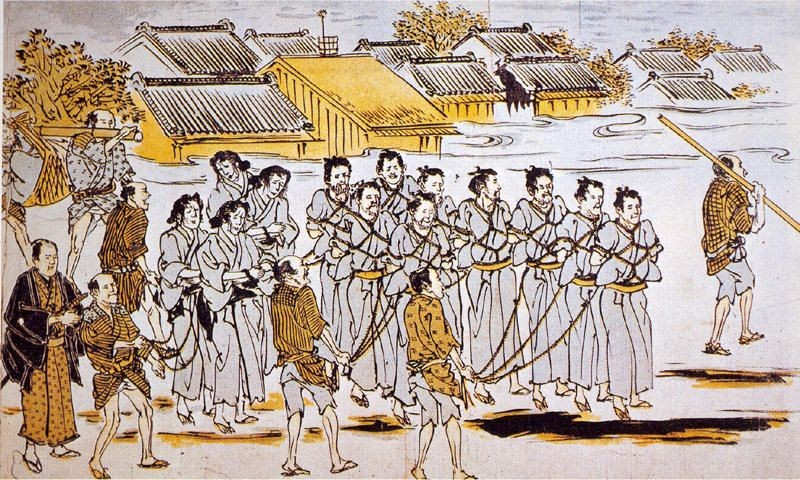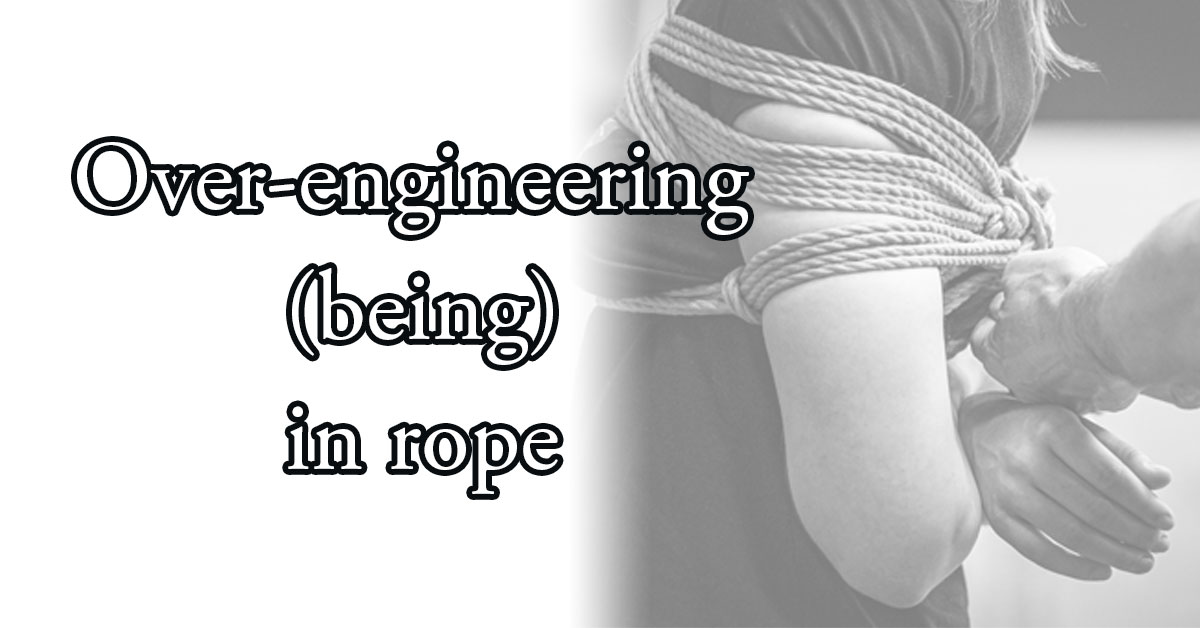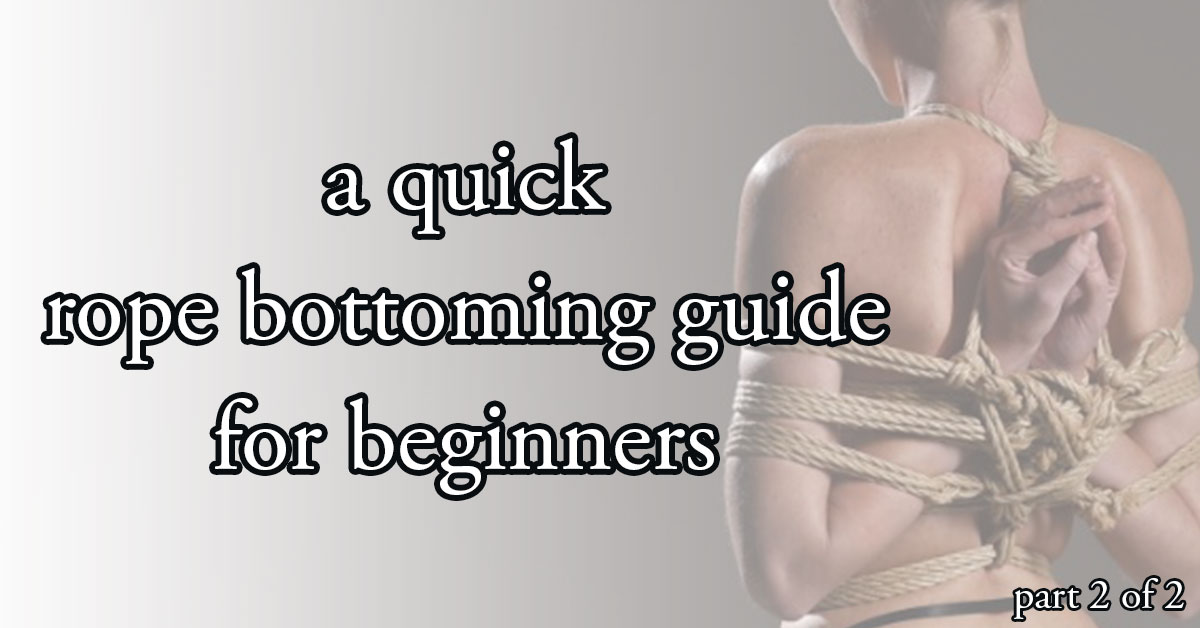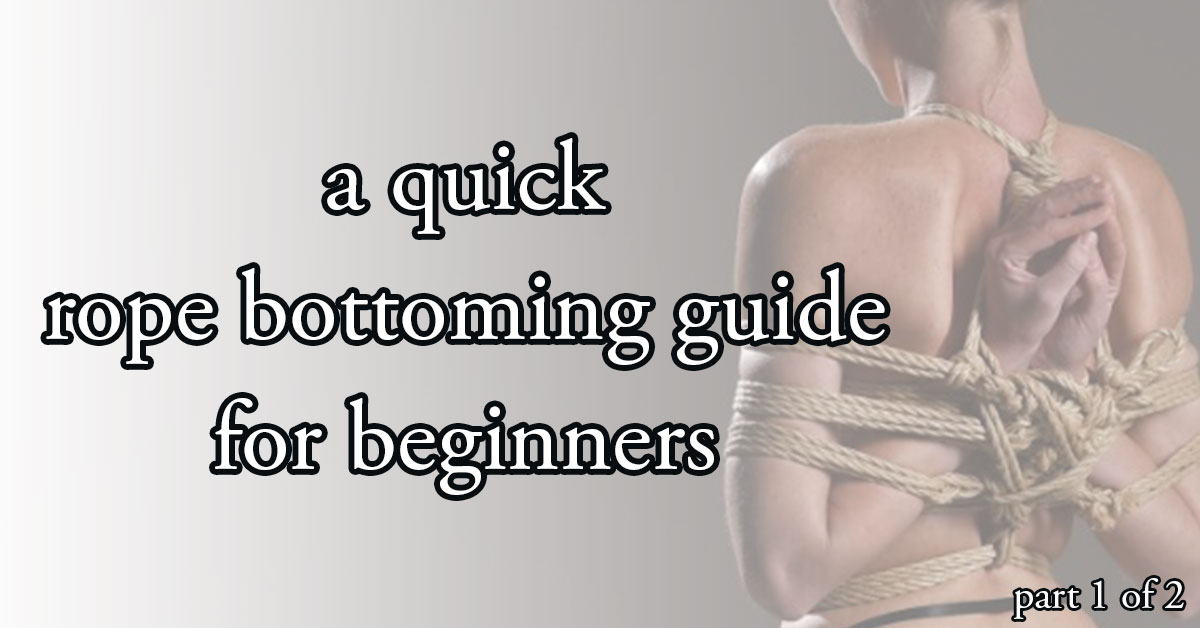One thing that must be understood about kinbaku is that it has a long history before it developed into the shibari that is practised in Japan today and has a direct link with the history of Japan. Trying to understand kinbaku means trying to understand the Japanese and their culture. This, and its actual beauty is a big part of the attraction of shibari today.
Rope, or more specific, tying “things” has a long history in Japan and can be traced back to as early as the Jomon (=rope pattern; prehistory 10,000 BC to 300 BC) period into contemporary Japan. It looks like everything in Japan is tied together, the kimono, battle armor, every sort of gift, etc.
It’s commonly accepted that the roots of Japanese bondage have started during the battle of Onin (an eleven year battle that started in 1467 in Kyoto) throughout the rest of the Sengoku period (1492-1600) into the Edo period (1600-1867) to the Meiji (1868-1912) period.
(see the periodization of Japanese history)
The Sengoku period (Sengoku Jidai, the Age of Warring States, the years of the samurai, those who serve) is best known for its cruelty. Some call it a period of hell on earth. Any type of rope bondage used during this period was used for capture, transport, interrogation, torture and punishment. Eroticism was last on their mind.
When during the self-imposed isolation of the Edo period the Tokugawa shogunate was in place and Japan enjoyed their longest period of uninterrupted peace. In 1742 the Tokugawa shogunate presented the foundation of crime laws. Part of these crime laws were four kinds of torture; whip, pressing stone, bend by rope (ebizeme) and hung by rope (tsurizeme). The importance of these four kinds of torture is that two of these, bend and hung by rope, are still used in today’s shibari. In other words, the foundation of today’s shibari was laid out by the Tokugawa shogunate in 1742.
During the Edo period catching, binding, torturing and punishing criminals was the job of lower class officials (i.e. Yoriki and Doshin). The use of rope to capture (arrest) and transport a prisoner turned into a official martial art skill called hojojutsu. This art was developed and maintained by Doshin. Different rope was required depending on the years season and different roping was required for people from a different class. Ropeing up wrongly would embarrass not just the criminals but also the officials. Today the Japanese police is still taught rope-tying techniques and there are a few martial art schools where you can still learn hojojutsu, a direct descendant of the Edo period hojojutsu.
Sometime into the Edo period when Japanese society was more stable and prospered, torture and punishment of prisoners, once private now open to the public, became more theatrical. Ukiyo-e (woodblock prints) artist began depicting torture and punishment for artistic purposes. Kabuki theater (then a commoners theater) was playing scenes of torture and sex. A Japanese genre depicting torture and punishment matured and became increasingly popular as a form of mass entertainment. The roots of current shibari comes significantly from this period.
In the late Edo period the combination of torture/punishment and sexual activity was first documented.
“The only recognition I ever received, as a person who has studied bondage since 1908, was the pervert tag” said Seiu Ito (1882-1961) in an article published in Amatoria magazine in 1953.
Seiu Ito (or Ito Seiyu) was born with a personal interest in S&M. He is commonly seen as the link between the old torture/punishment practices and the new S&M practices. Ito was a painter, ukiyo-e master, photographer and writer and had a talent to capture “beauty in suffering”.
During the Taisho period (1912-1926) he began taking photographs. In 1919, at the age of almost forty, he created his most famous work, “Maidens suffering in the snow”. By the mid 1920’s there were already a few “abnormal” magazines (S&M Erotic Photo magazines), all of which featured Ito’s work. His fame reached a peak in 1924 when he was visited in his own studio the be interviewed for the “Sunday mainichi magazine”, a “normal” magazine.
After World War II (1939-1945), in 1948, the pulp magazine “Kitan Club” (strange tales club) was launched as an erotic magazine for “normal” people. By now Ito’s work had begun to influence a new generation of people, editors and artists. In 1953 Kitan Club transformed into an authentic “abnormal” magazine. The transformation was the effect of a series of bondage pictures by Kita Reiko (aka Suma Toshiyuki-editor of Kitan Club and Urumada, aka Minomura Ko-a novelist). Kita Reiko claimed to be the “last disciple of bondage master Seiu Ito”.
The Uramado magazine was launched in 1955. Initially a magazine of period novels, it transformed into an S&M magazine around 1960 due largely to the effort of Lida Toyokazu, ex-editor of Kitan Club. Lida later became the major contributor, known as master roper Nureki Chimuo, to the golden days of S&M magazines in the seventies and to the rise of S&M videos later.
Our current shibari masters and lovers all credit Ito’s work as an important influence in their own work, people like (but not limited to) Akechi Denki (1940-2005), Osada Eikichi (1925-2001), Chiba Eizoh, Randa Mai and Akio Fuji. You could say, the spirit of Seiu Ito, the great rope master, has been handed down to the present day via the “abnormal” magazines of the fifties.
Bob (
RopeMarks
)
February 2007
A translated version of this article is published in Finish magazine Tabu
References:
- RopeMarks Artistic Rope Exchange (R.A.R.E.)
- The History of Japan (The Greenwood Histories of the Modern Nations) by Louis G. Perez
- War in Japan 1467-1615 (Essential Histories) by Stephen Turnbull
- Military History Online
- The Seductive Art of Japanese Bondage by Midori
- Shibari, The Art of Japanse Bondage by Master “K”
- CD inlay booklet of Merzbow’s Music for Bondage Performance 2 by Masami Akita
- Kikkou
- Wiki pedia
- discussions with different people (Japanese and Western)
- discussions I participated in on different mailing lists.













Hey there. Thank you so much for your articles. They are really helping me to prepare my master thesis on shibari.
I was wondering where you got some of the historic pictures in your articles or who holds the copyright?
Thank you.
Eva
Hi Eva, Most images are internet finds without credits. I consider these public domain until I get feedback they are not. good luck with your thesis!